Please add some products from our shop, so we can generate a quote for you.
SUPPLY - DELIVER – INSTALL
Water tank installation | rainwater tank installation
APR Tanks is a South Australian family-owned and operated business. We make a range of polyethylene tanks from our 1,000 slimline to the cost effective 20,000 litre round, all delivered within our free delivery area. All our tanks are made from a certified, virgin, BPA free, food grade material with UV protention.
Not only do we manufacture the tanks locally, we can also assist in finding quality installation contractors in the following regions; Adelaide Metropolitan Area, Adelaide Hills,Mid North and Barossa, Mount Barker and Fleurieu Peninsula.
COMMON SERVICES
- Site assessment
- Site preparation
- Removal and disposal of old tanks
- Base preparation
- Stormwater connection
- Plumbing connection
We can help with gutter connection, base preparation, pumps, plumbing, and rainwater tank connection.
Call us today to discuss your requirements. (08) 8359 4999
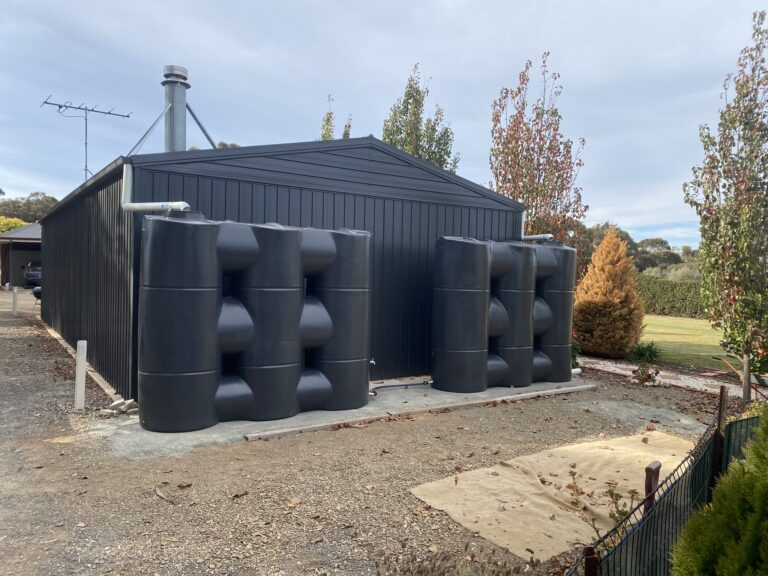
What is a Round Water Tank?
We offer a range of round rainwater tanks to suit your budget and space requirements. Larger tanks are designed for greater water storage capacity and can be installed anywhere on your property. The tanks range from 1,000 litres to 20,000 litre capacity.
What is a Slimline Water Tank?
Slimline tanks are an ideal water storage solution for small spaces. The slim shape is designed to fit down the side of a house or alongside a fence. Perfect for high-density urban areas where space is limited.
Water Tank Installation
We can arrange the following water tank installation services:
- Removal and disposal of old tanks
- Base preparation
- Stormwater connection
- Plumbing connection
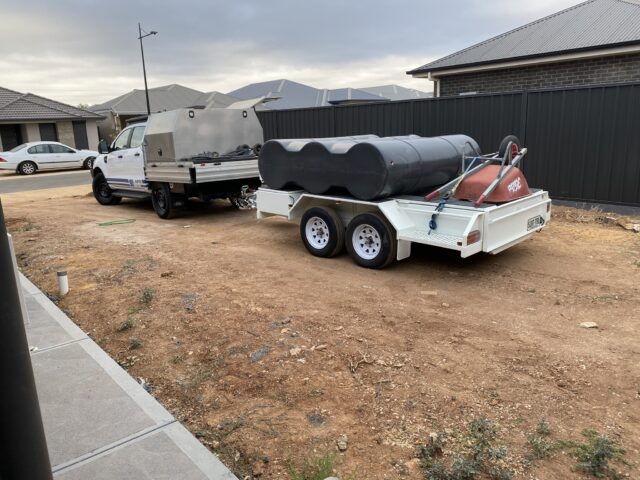
1.Water Tank Site Inspection
Our experienced and friendly team will request photos of the site to understand what is required. We may visit your site to discuss your requirements and recommend the most suitable system.
2.Removal of Old Water Tank
Removal of old metal tanks
- Tank must empty as much as possible
- Dispose of sediment onsite
- Ground level or on a stand
- Suitable access is required
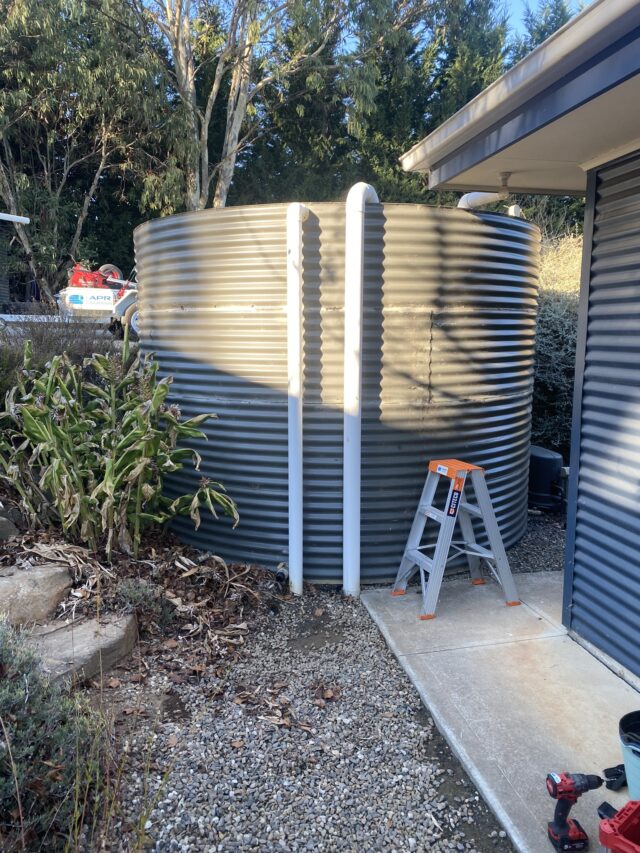
3.Base Preparation for Water Tank
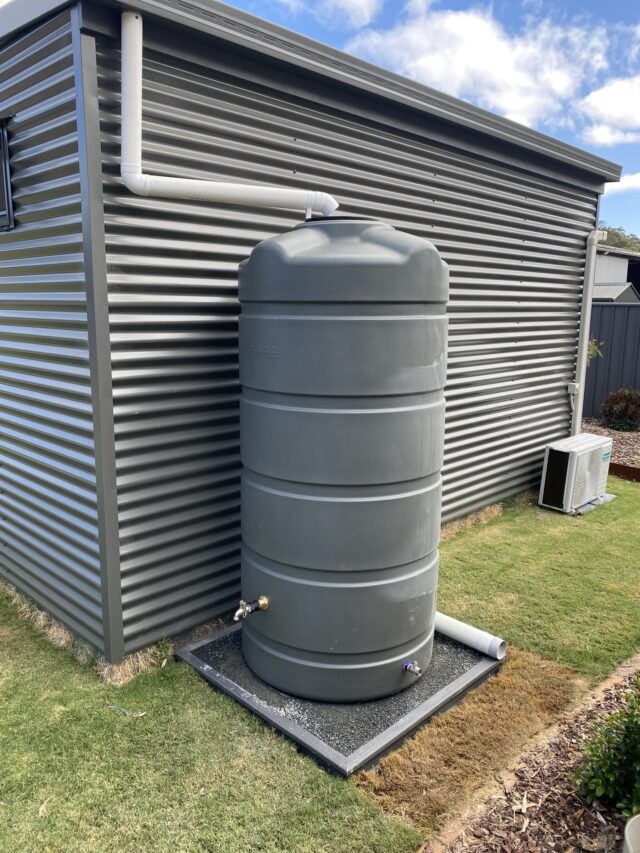
Ensuring the correct base preparation for your tank is critical. One litre of water weighs 1kg and the total tank weight can be over 20 tonne. We’ll visit your site and discuss the most suitable and cost-effective solution for your rain harvesting system.
A firm and level base is required. APR recommends a 75mm compacted dolomite, sand, or a concrete base with at least a 200mm distance between the tank wall and edge of the tank base. The base area may need to be boxed in to prevent erosion from wind and rain. APR can supply a range of eco-friendly borders suitable for this work. It is also critical that the overflow is connected and plumbed away from the base to prevent scouring.
If the tank is to go on a wooden platform, it must be 200mm bigger than the tank diameter, suitably constructed, and strong enough for the combined weight of a full tank, with no more than a 40mm gap between the timbers.
- Dolomite bases for slimline tanks
- Suitable access is needed
- Ground must be level
4.Stormwater Connection
Your storm water system is an important factor in an effective rain harvesting system. It is important to ensure your pipe work doesn’t trap leaves and debris or hold stagnant water or become a mozzie breeding ground.
- Simple gutter connection
- Inlet and overflow to tank connection
- Suitable location to plumb the overflow
- A stormwater detention outlet can be added to the side of the tank to meet council requirements

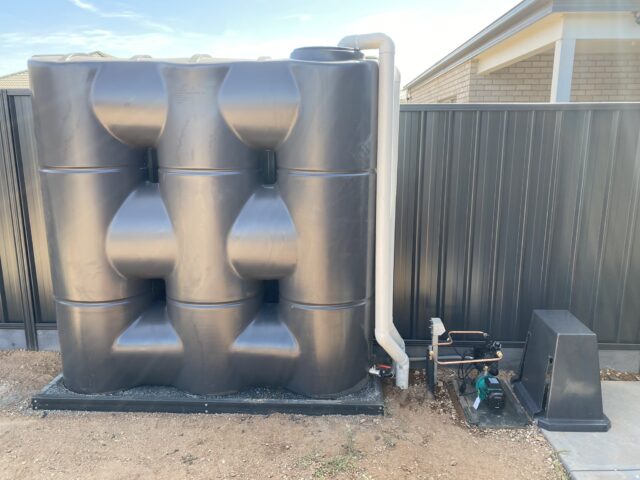
5.Plumbing & Electrical Connection
Our plumbing installations are carried out by licensed plumbers. Whether it’s a simple connection for a new home or a complete connection to your whole home and irrigation system we can help. Most rain harvesting systems require power to connect a pump and accessories.
Tank Accessories
Your storm water system is an important factor in an effective rain harvesting system. It is important to ensure your pipe work doesn’t trap leaves and debris or hold stagnant water or become a mozzie breeding ground.
- Tank Outlets & Ball Valves
- Flexible Hose Connections
- Leaf Strainers & Lids
- Overflow Outlets
- Tank Gauges
Browse Accessories

Water tank installation codes in Adelaide mandate rainwater storage systems for new dwellings and certain extensions. The regulations stipulate a minimum 1000-liter tank capacity, plumbed to toilets, water heaters, or laundry cold water outlets. Tanks must feature overflow devices and mosquito-proof screens. Licensed plumbers must install piping systems and provide compliance certificates. Specific council requirements may vary, encompassing auto-switching systems, fire-fighting water retention, and stormwater detention. The South Australian government implemented these measures to promote sustainable water use. Building plans must detail tank specifications, including size, location, catchment area, and plumbing details. Installations must adhere to Australian and New Zealand Plumbing and Drainage Standards, with proper labeling of rainwater-supplied fixtures
Rebates and incentives for water tank installation in Adelaide are designed to promote sustainable water use. Rebates and incentives may be available through local councils or state governments. These incentives aim to reduce reliance on mains water and encourage the use of rainwater for everyday household activities, contributing to water conservation efforts in South Australia.
Reference:
https://www.sa.gov.au/topics/energy-and-environment/energy-efficient-home-design/rainwater-tanks
Water tank installation regulations in Adelaide are a set of mandatory guidelines for new dwellings and certain extensions. These rules stipulate a minimum 1000-liter tank capacity, plumbed to toilets, water heaters, or laundry cold water outlets. Tanks must feature overflow devices and mosquito-proof screens. Licensed plumbers must install piping systems and provide compliance certificates.Building plans must detail tank specifications, including size, location, catchment area, and plumbing details. Installations must adhere to Australian and New Zealand Plumbing and Drainage Standards (AS/NZS 3500). Specific council requirements may encompass auto-switching systems, fire-fighting water retention, and stormwater detention. The South Australian government implemented these measures to promote sustainable water use. Rainwater-supplied fixtures require proper labeling, with "RAINWATER" markings on pipes and outlets. Commercial or community tanks necessitate routine water quality testing to ensure potability.
Yes, water tank installation approval in Adelaide is required and is governed by specific regulations. New dwellings and extensions over 50 square meters require a minimum 1,000-liter rainwater tank plumbed to a toilet, water heater, or laundry cold water outlet. Most residential installations do not need council approval unless the tank exceeds 10 square meters in area or 4 meters in height. Tanks must have mosquito-proof screens, overflow devices, and be installed by licensed plumbers. Commercial or community tanks require routine water quality testing. These rules aim to promote water conservation and sustainable urban development in South Australia's variable climate.
Determining the optimal water tank location involves evaluating several crucial factors. A level site away from retaining walls minimizes installation costs and ensures stability. Proximity to downpipes enhances water harvesting efficiency, while strategic placement near laundry facilities or toilets reduces plumbing expenses. Aesthetic considerations often favor less visible areas. The tank's size and property layout influence positioning options. Proper elevation above ground level prevents contamination, with specific height requirements for different tank types. Accessibility for maintenance and connection to existing plumbing infrastructure are vital. Local regulations and soil conditions may impose additional constraints.
Water tank installation is a multi-step process that varies in duration based on tank size, type, and site conditions. The timeline ranges from 1-5 weeks, encompassing site preparation, delivery, and assembly. Large rural tanks often require 1-2 days for on-site construction by specialized crews. Smaller polyethylene tanks may be installed more rapidly. Site preparation involves creating a level sand pad, ensuring proper drainage, and meeting local regulations. Post-installation tasks include connecting plumbing, setting up filtration systems, and adding protective aggregate around the tank base. The installation's complexity affects overall duration, with factors like pump setup and plumbing integration potentially extending the timeline.
Commercial water tank installation offers numerous benefits for businesses, ensuring operational efficiency and sustainability. A commercial water tank is a specialized container designed to store water for various uses, including drinking, cleaning, and industrial processes. These tanks can be pressurized or atmospheric and are available in various sizes and materials, tailored to meet specific business needs.
Reliable Water Supply: Installing a water tank guarantees a stable and uninterrupted water supply, crucial for businesses that rely heavily on water, such as restaurants, hotels, and manufacturing facilities. This mitigates the risk of operational downtime due to water shortages or infrastructure issues.
Cost Savings: By utilizing stored water, businesses can reduce their reliance on municipal water sources, leading to significant savings on water bills. Rainwater harvesting systems integrated with water tanks can further enhance cost efficiency by collecting and using free rainwater.
Sustainability: Water tanks contribute to environmental sustainability by promoting water conservation. They enable businesses to reduce their carbon footprint and demonstrate eco-friendly practices, which can enhance their corporate image and appeal to environmentally conscious consumers and stakeholders.
Operational Continuity: In the event of natural disasters, infrastructure failures, or maintenance activities, having a backup water supply ensures that business operations continue smoothly without significant disruptions. This is particularly important for industries where water is essential for safety measures, such as fire suppression and cooling systems.
Versatility and Adaptability: Commercial water tanks are versatile and can be used for various applications, including irrigation, industrial manufacturing, and fire protection. They are available in different configurations to suit specific business requirements, whether for temporary or permanent installations.
Improved Water Quality: Modern water tanks are designed to maintain high water quality by preventing contamination and minimizing bacterial growth. This ensures that the stored water remains clean and safe for all intended uses.

